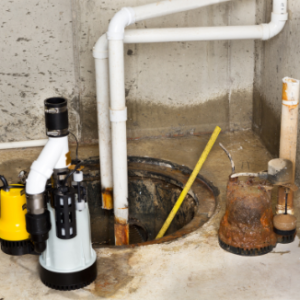
Understanding how one operates and the reasons for sump pump failure can help you diagnose the problem and get it working again quickly.
How A Sump Pump Works
A sump pump is a piece of equipment that moves water from your basement out of your home. The submersible device is placed into a sump pit that is carved into the lowest point of your home, usually the basement floor.
Most of the time the sump pump is on standby. When it begins to rain heavily, or your home experiences basement flooding from another source, the soil around your house will begin to oversaturate. That water then begins to enter your home, and the pit starts to fill with standing water.
Once the water reaches a float switch on the sump pump, the sump pump is triggered and turns on. The water is then pumped from the pit and drained through a discharge line into a nearby storm drain, well, or pond. Sump pumps prevent water from flooding a home.
Why Sump Pumps Fail
Sump pumps are the first line of defense against flooding, and when they fail, they can make the problem worse or even cause flooding. The most common reasons that sump pumps fail are:
- Overwhelmed with Water: Sometimes there is just TOO much water for a sump pump to properly work. Sump pumps can fail when they cannot keep up with the amount of water flowing into it, especially during heavy rains.
- Clogged with Debris: Sump pumps can clog in many ways. The most common? Sump pumps that do not have a lid! An exposed sump pump can collect debris that will eventually block the pump from doing its job. Lids are also important to seal off any radon gas that is emitted, earthy smells, humidity, and moisture.
- Frozen or Backed Up Discharge Pipe: The discharge pipe is where the water is transported out from the basement. The discharge pipe can freeze during the winter resulting in a sump pump failure. While freezing is difficult to prevent, some systems have a separate discharge line in case the main pipe becomes frozen or clogged.
- Stuck Switch: The most common mechanical problem in a sump pump is a stuck switch. This happens when the pump shifts inside the pit, causing the float switch to fail by lodging itself against the side of the pump. Debris can also jam the switch.
- Lack of Maintenance: Sump pumps don’t get much attention from homeowners. At the very least, sump pumps require maintenance once a year.
- Old Age: Depending on use, sump pumps have a lifespan of 10 years. If the age of your sump pump is in the double digits, it may be at risk to fail during the next storm.
- Loss of Power: Power outages during storms are very common, and can create a headache for homeowners who rely on sump pumps to keep their basements dry. Unfortunately, this is a hard problem to fix without a backup generator or a hand pump. Power outages can last days – even weeks – with natural disasters or catastrophes.
Steps to Take After A Sump Pump Stops Working
If your sump pump stops working, there are some things you can do to troubleshoot until you can have it repaired or replaced. In most instances, sump pump failures happen at the most inconvenient times, so acting quickly can help stop flooding or extensive water damage.
- If a power outage is not the cause of the failure, and there is water flooding in the basement, you should turn off the electric breaker before entering the space. Water and electricity can be dangerous.
- Visually inspect the sump pump and the pit. Check to see if the float switch is lodged and unable to activate the pump. If it is lodged, free it from the side of the sump pump.
- If you are unable to get the sump pump to start working again, focus on removing the excess water from the basement as quickly as possible. If the water level isn’t too high, you can use mops and buckets to clean up the water. Wet/dry vacuum can help speed up the process, and save you some work, too.
- If you cannot keep up with removing the water, call a flood damage restoration company to help as soon as possible. They have the proper tools and equipment to remove water and dry the space quickly.
Learn About Our Water Damage Restoration Services
Water Damage Restoration Specialists
If you have an emergency due to the failure of a sump pump, call Reynolds Restoration Services for help. Our team of residential water and flood damage specialists is on-call 24/7 to respond. Flooded basements can lead to more serious problems like mold infestation or structural damage. In most cases, we can be on-site within an hour of Harrisburg, PA, Philadelphia, PA, and Baltimore, MD. Our flood damage restoration process will help restore your home to its pre-loss condition quickly.

President of Reynolds Restoration Services. Over 20 years of experience in the emergency restoration industry.

